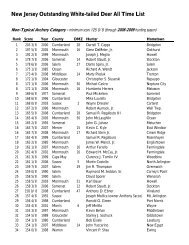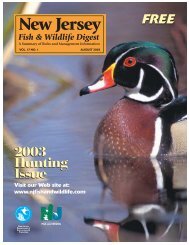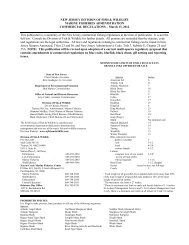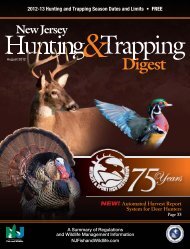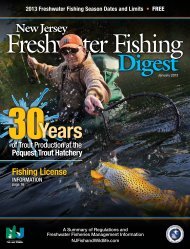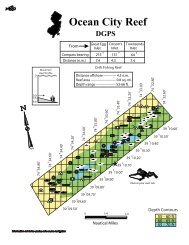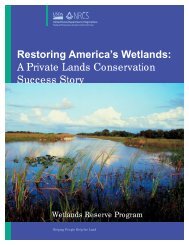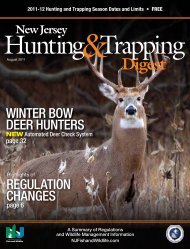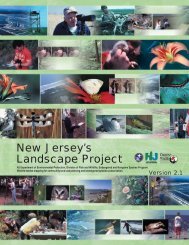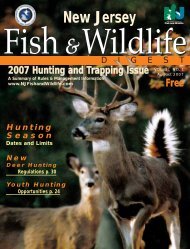Complete 2009 Marine Issue of the Fish and Wildlife DIGEST
Complete 2009 Marine Issue of the Fish and Wildlife DIGEST
Complete 2009 Marine Issue of the Fish and Wildlife DIGEST
You also want an ePaper? Increase the reach of your titles
YUMPU automatically turns print PDFs into web optimized ePapers that Google loves.
Attention Saltwater Anglers!<br />
By Jeff Brust, Research Scientist<br />
New Jersey Division <strong>of</strong> <strong>Fish</strong> <strong>and</strong> <strong>Wildlife</strong> has implemented an angler survey to collect information<br />
on certain recreationally important marine finfish species. This voluntary survey is available online<br />
at http://NJ<strong>Fish</strong><strong>and</strong><strong>Wildlife</strong>.com/marinesurvey.htm.<br />
Since 1981, <strong>the</strong> <strong>Marine</strong> Recreational <strong>Fish</strong>eries Statistics Survey<br />
(MRFSS), conducted by <strong>the</strong> National <strong>Marine</strong> <strong>Fish</strong>eries Service<br />
(NMFS) has been <strong>the</strong> primary source <strong>of</strong> recreational fisheries<br />
data in New Jersey <strong>and</strong> o<strong>the</strong>r coastal states throughout<br />
<strong>the</strong> U.S. Unfortunately, <strong>the</strong> MRFSS is hindered by sampling<br />
only a small portion <strong>of</strong> <strong>the</strong> fishing public <strong>and</strong> by collecting<br />
only minimal data on released fish. Although NMFS is in <strong>the</strong><br />
process <strong>of</strong> developing an improved sampling program (<strong>Marine</strong><br />
Recreational Information Program or MRIP), details <strong>of</strong> <strong>the</strong> new<br />
sampling program are not yet available. It may be several years<br />
before fisheries scientists can determine <strong>the</strong> utility <strong>of</strong> <strong>the</strong> data<br />
collected through MRIP.<br />
Information collected through <strong>Fish</strong> <strong>and</strong> <strong>Wildlife</strong>’s new voluntary<br />
marine angler survey will provide much-needed data<br />
to increase our underst<strong>and</strong>ing <strong>of</strong> New Jersey’s highly valued<br />
recreational fisheries. The focus <strong>of</strong> this voluntary survey is to<br />
learn catch <strong>and</strong> effort information from fishing trips in marine<br />
<strong>and</strong> estuarine waters <strong>of</strong> <strong>the</strong> state <strong>and</strong> surrounding areas. For<br />
catch information, <strong>Fish</strong> <strong>and</strong> <strong>Wildlife</strong> is interested in collecting<br />
statistics on <strong>the</strong> number <strong>and</strong> size <strong>of</strong> fish both kept <strong>and</strong><br />
released.<br />
One <strong>of</strong> <strong>the</strong> more valuable benefits <strong>of</strong> this survey is<br />
<strong>the</strong> collection <strong>of</strong> lengths from released fish. The<br />
MRFSS collected no length information from<br />
released fish until 2004 when it began measuring<br />
throwbacks from a limited number <strong>of</strong> party boat<br />
trips. New Jersey’s online survey allows for collection<br />
<strong>of</strong> lengths <strong>of</strong> released fish from all fishing modes<br />
<strong>and</strong> species. This information is particularly useful<br />
in underst<strong>and</strong>ing <strong>the</strong> population size structure <strong>and</strong><br />
for use in population models. The figure below<br />
shows <strong>the</strong> size distribution <strong>of</strong> recreationally caught<br />
summer flounder during <strong>the</strong> 2008 fishing season.<br />
Your participation in <strong>the</strong> survey is both important<br />
<strong>and</strong> appreciated. <strong>Fish</strong> <strong>and</strong> <strong>Wildlife</strong> is confident that<br />
quality recreational fisheries data collected through<br />
<strong>the</strong> online survey will improve our ability to manage<br />
our important marine species for continued enjoyment<br />
by recreational anglers <strong>and</strong> all user groups.<br />
Go to NJ<strong>Fish</strong><strong>and</strong><strong>Wildlife</strong>.com/marinesurvey.htm<br />
The survey was implemented in June 2008 <strong>and</strong> by <strong>the</strong><br />
end <strong>of</strong> <strong>the</strong> year had received more than<br />
675 responses reporting catch <strong>and</strong><br />
effort information on more than<br />
1,850 angler trips. The majority <strong>of</strong><br />
responses (521) identified summer<br />
flounder as ei<strong>the</strong>r a primary or secondary<br />
target species, with striped<br />
bass (141), bluefish (130), weakfish (89)<br />
<strong>and</strong> black seabass (85) rounding out <strong>the</strong><br />
top five most-targeted species.<br />
30.0<br />
25.0<br />
20.0<br />
15.0<br />
10.0<br />
5.0<br />
0.0<br />
Percent Frequency<br />
2008<br />
18" Minimum size<br />
Length<br />
(inches)<br />
5 6 7 8 9 10 11 12 13 14 15 16 17 18 19 20 21 22 23 24 25 26 27 28 30<br />
Figure 1. Length frequency<br />
distribution <strong>of</strong> summer flounder caught<br />
during <strong>the</strong> 2008 fishing season reported through<br />
New Jersey’s online volunteer marine angler survey.<br />
8 | New Jersey <strong>Fish</strong> & <strong>Wildlife</strong> Digest May <strong>2009</strong><br />
<strong>2009</strong> <strong>Marine</strong> <strong>Issue</strong> NJ<strong>Fish</strong><strong>and</strong><strong>Wildlife</strong>.com





